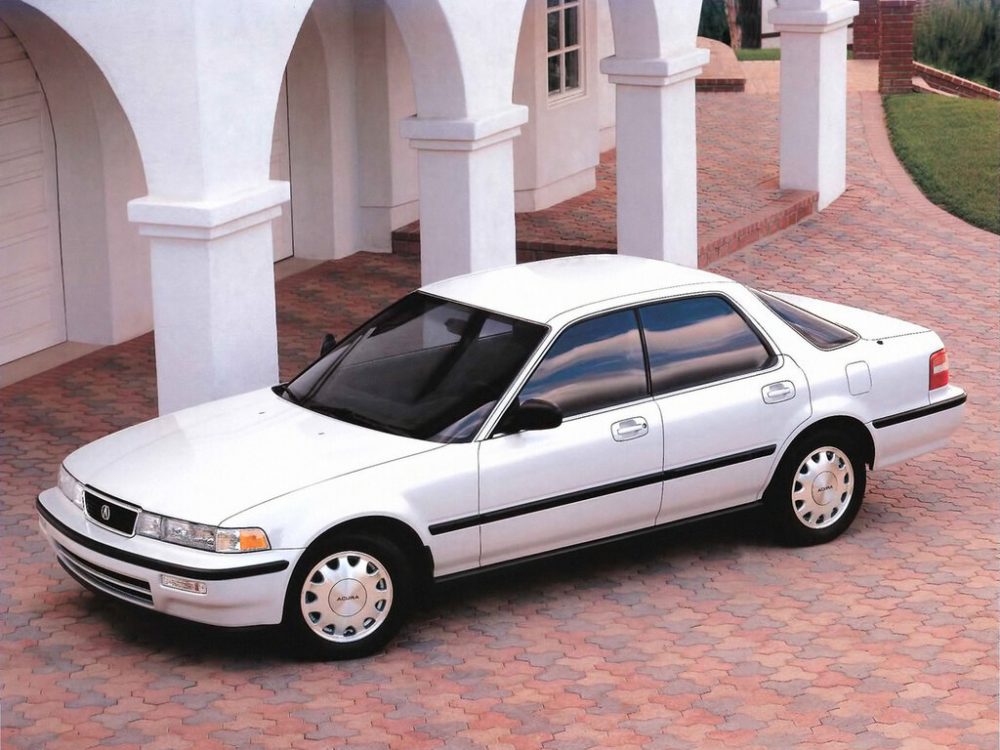The early 1990s marked a golden age for Japanese luxury cars, yet among the legends stands an often-overlooked masterpiece. The Acura Vigor emerged in 1991 as Honda’s bold experiment, challenging conventional wisdom with its unique five-cylinder engine and distinctive engineering approach.
This four-door sedan carved its own niche between the compact Integra and flagship Legend, bringing unexpected innovations to a market saturated with predictable V6 powerplants. Its brief three-year run from 1991 to 1994 left an indelible mark on automotive history, even if most people have forgotten its existence.
Engineering Brilliance: The Unconventional Heart
The Vigor’s crowning achievement rests under its hood – a longitudinally mounted 2.5-liter five-cylinder engine. This G25A powerplant pumped out 176 horsepower, delivering smooth acceleration and a unique engine note that set it apart from every other luxury sedan of its era.
Each cylinder fired in perfect sequence, creating a distinctive rhythm that true car enthusiasts still remember. The engine’s longitudinal placement, typically reserved for rear-wheel-drive vehicles, showcased Honda’s willingness to break conventional design rules.
“I’ve owned many luxury cars, but nothing matches the character of my Vigor’s five-cylinder engine. The sound, the power delivery – it’s simply magical. Even after 30 years, it still puts a smile on my face every time I start it up.” – Michael Chen, Vigor owner since 1993
The unusual engine configuration resulted in better weight distribution and reduced torque steer, problems that often plagued powerful front-wheel-drive cars of the era. Engineers managed to combine this unique powertrain with either a crisp 5-speed manual or a smooth-shifting automatic transmission.
Design and Comfort: Japanese Luxury Redefined
At 190.4 inches long and 70.1 inches wide, the Vigor struck an ideal balance between presence and maneuverability. Its hardtop sedan design eliminated traditional B-pillars, creating an elegant greenhouse that emphasized openness and visibility.
The following features defined the Vigor’s premium positioning:
- hand-selected leather upholstery with precise stitching;
- real wood trim elements across the dashboard;
- acoustically engineered cabin for minimal road noise;
- ergonomically optimized control layout.
The interior craftsmanship reflected Acura’s attention to detail, with premium materials and thoughtful ergonomics throughout. This dedication to quality helped justify its $27,995 starting price in 1994.
Performance and Handling: A Driver’s Delight
The Vigor’s performance credentials went far beyond its unique engine. The chassis tuning struck a remarkable balance between comfort and sportiness, making it equally capable on twisty back roads and long highway stretches.
“Working as a test driver in the early ’90s, I evaluated dozens of luxury sedans. The Vigor always stood out for its precise handling and unique character. It wasn’t the fastest or the most luxurious, but it had soul.” – James Miller, former automotive journalist
Quick steering responses and well-controlled body motions made the car feel smaller than its dimensions suggested. Zero to 60 mph arrived in just over 8 seconds – respectable figures for its time – while the top speed approached 130 mph.
Legacy and Collectibility: A Rising Star
Today, finding a well-preserved Vigor proves challenging, with only 43,000 units sold during its production run. This rarity, combined with its unique engineering and historical significance, makes it an increasingly attractive option for collectors.
The market has begun recognizing the Vigor’s special place in automotive history. While Legend prices have remained relatively stable, clean Vigors have seen steady appreciation over the past decade.
Time has proven the Vigor’s forward-thinking design choices. Many modern luxury cars now employ similar engineering solutions, validating Acura’s innovative approach from three decades ago.
Beyond the Specifications
The Vigor represents more than just another luxury sedan from the 1990s. It embodies the spirit of innovation that defined Japan’s golden age of automotive engineering, when manufacturers dared to challenge established norms.
Its relative commercial failure perhaps says more about market conservatism than the car’s actual merits. The Vigor refused to conform to expectations, and in doing so, created something truly special.
Pros and Cons
| Advantages | Disadvantages |
|---|---|
| Unique five-cylinder engine delivers distinctive character and smooth power delivery | Limited production run means parts availability can be challenging |
| Excellent build quality with premium materials throughout | Fuel economy falls short of some contemporary competitors |
| Advanced safety features including standard ABS and driver’s airbag | Tight rear seat space compared to similarly sized sedans |
| Precise handling balance thanks to longitudinal engine layout | Complex engineering design can make maintenance costly |
| Rare collectible status with rising value potential | Limited aftermarket support compared to other Acura models |
| Innovative engineering solutions ahead of their time | Original pricing positioned it awkwardly between market segments |
The Acura Vigor stands as a testament to engineering boldness and the pursuit of automotive excellence. While it may not have achieved the commercial success of its siblings, it earned its place in history as one of the most intriguing luxury sedans of its era.

